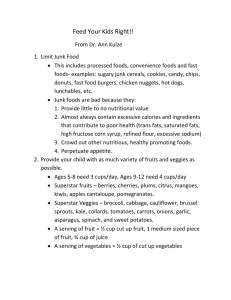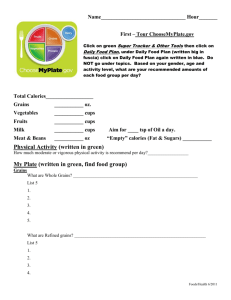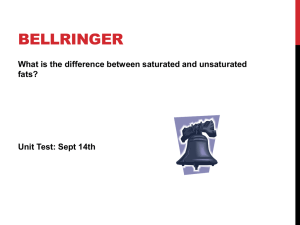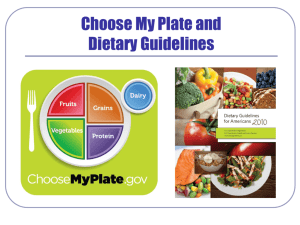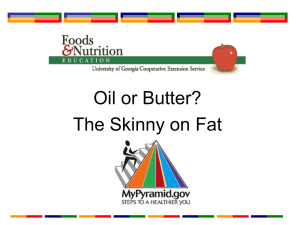Nutrition in Nursing - Career Educational Pathways
advertisement
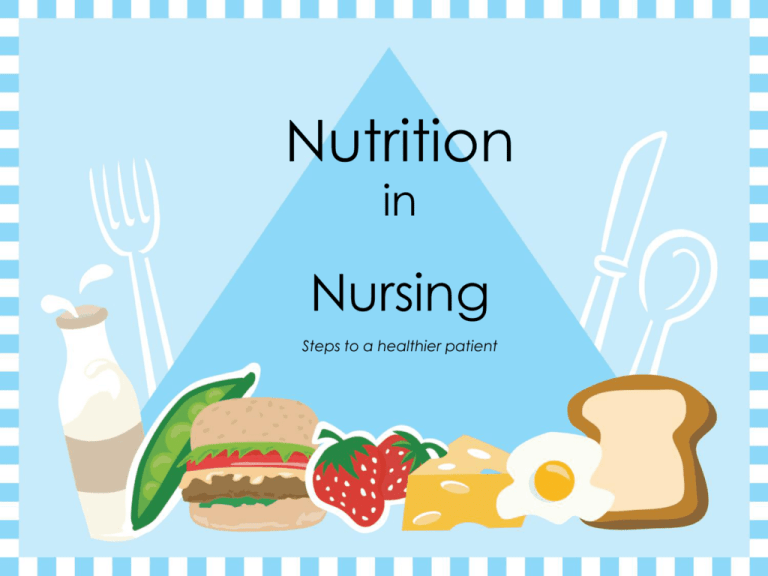
Nutrition in Nursing Steps to a healthier patient Overview of Nutrients Proteins (macronutrients)-required for proper growth & development; composed of amino acids. Adult recommended daily allowance (RDA) -0.8 grams/kg/day, 10% total calories Additional protein needed for infants, children, and pregnant or lactating women. Insufficient amounts can lead to protein energy malnutrition- i.e. atrophy and wasting away of muscle & poor wound healing. Overview of Nutrients Carbohydrates-macronutrients: include starches, sugars (fructose, glucose, lactose, sucrose), and cellulose 4 calories/gram; are key source of energy. Found in fruits, vegtables, milk, and grains Promotes normal metabolism, including fat metabolism Spares protein Insufficient amount results for protein and fat being used up. Overview of Nutrients Fats (macronutrients): Concentrated sources of energy, provides 9 calaries/gram Needed for proper absorption of fat-soluble vitamins Stored in body to maintain body warmth and cushion or protect internal organs. Sources include animal products-i.e., egg yolk, organ meat, butter, cheese, various oils. The cholesterol content determine if the fat is- saturated, monounsaturated, or polyunsaturated. The more solid the fat the higher the saturated fat. Leads to obesity, heart disease, and some cancers if taken in large amounts over a long period of time. Insufficient intake can result in ↑ risk infection, skin lesions, amenorrhea, and cold sensitivity (no fat stores). Overview of Nutrients Minerals (micronutrients): Part of the bones, cells, and hormones. Enhances cellular function Widely abundant in foods. Major minerals-calcium, sodium, potassium, magnesium, chloride, and phosphorus. Trace elements-iron, iodine, copper, zinc, selenium, manganese, flouride, chromium, and molybdenum. Mineral intake can also be supplemented-usually as a multivitamin. Overview of Nutrients Vitamins (micronutrients): classified as water soluble (B and C vitamins)-easily excreted from the body or fat soluble (vitamins A, D, E, K)-which can be stored and cause toxicity if taken to excess. Used as catalysts of body functions, coenzymes in metabolic processed, for growth, collagen production, wound healing, hormone synthesis, and vision. Can be obtained through diet alone or supplementation. Depends on the supplement- for example: Folic acid-is found in orange juice, meat, leafy green vegtables-If there is a deficiency it can cause nutritional anemia or neural tube defects in unborn chidren. The Food Pyramid Steps to a healthier you GRAINS VEGETABLES FRUITS OILS MILK MEAT & BEANS Grains Make half of your grains whole List a few examples of grains that are plentiful in your area. Discuss how much children should eat every day and when they might have them. Together, research and discuss the health benefits of grains. Encourage children to list foods that they like from this food group. Vegetables Vary your veggies List a few examples of vegetables that are plentiful in your area. Discuss how much children should eat every day and when they might have them. Together, research and discuss the health benefits of vegetables. Encourage children to list foods that they like from this food group. Fruits Focus on fruits List a few examples of fruits that are plentiful in your area. Discuss how much children should eat every day and when they might have them. Together, research and discuss the health benefits of fruits. Encourage children to list foods that they like from this food group. Oils Know your fats List a few examples of oils and fats. Discuss how much children should eat daily and what foods contain oils and fats. Together, research and discuss the health benefits associated with the different kinds of oils and fats. Encourage children to list foods that they like from this food group. Milk Get your calcium rich foods List a few examples of milk products. Discuss how much children should eat daily and when they might have them. Together, research and discuss the health benefits of milk products. Encourage children to list foods that they like from this food group. Meat and Beans Go lean on protein List a few examples of meat and bean products that are plentiful in your area. Discuss how much children should eat daily and when they might have them. Together, research and discuss the health benefits of meat and beans. Encourage children to list foods that they like from this food group. Discretionary Calories Extras for luxury foods What are discretionary calories? Discuss how many discretionary calories children should eat every day. Solicit class feedback for examples of ways to use discretionary calories. Physical Activity Strive for 60 minutes or more per day What is physical activity? Discuss moderate vs. vigorous activity. Solicit class feedback for examples of moderate and vigorous activities. Eat Well and Stay Healthy! Encourage children to use the MyPyramid Worksheet, for a week, and to eat their favorite foods in each group to meet their daily requirements. Download the worksheet here: MyPyramid Worksheet. Discuss their findings at the end of the week. How might each child eat more healthfully? Conclusion Summarize the health benefits of each food group. Encourage children to do research on any new finding about food and health. Encourage children to continue keeping a food diary. Encourage children to strive for 60 minutes or more of physical activity every day. Ask your school nurse or doctor to visit the class to share facts about food and health on an ongoing basis.

